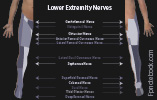II. Indications
- Regional Anesthesia to allow for procedures (in place of Procedural Sedation)
- Severe localized pain control (e.g. Ankle Fracture)
- Consider Hematoma Block
III. Contraindications
IV. Types: Leg
- Images
- Hip
- Lower leg (below knee)
- Popliteal Sciatic Nerve Block (peroneal nerve and tibial nerve)
-
Ankle
- Regional Anesthesia of the Anterior Ankle
-
Regional Anesthesia of the Posterior Ankle
-
Posterior Tibial Nerve Block
- Anesthesia of the majority of heel and sole of foot
-
Sural Nerve Block
- Anesthesia of the lateral heel and sole of foot
-
Posterior Tibial Nerve Block
V. Technique: Complete Lower Leg Anesthesia
- Background
- Proximal block requires only 2 Nerve Blocks (compared with the ankle, where 5 nerves must be blocked)
- Results in foot and ankle motor (paralysis) and sensory Anesthesia
- Blocks
- Distal Sciatic Nerve Block
- Anesthesia of most of the lower leg (except medial ankle and foot)
- Saphenous Nerve Block
- Anesthesia of the medial ankle and medial foot
- Distal Sciatic Nerve Block
VI. Technique: Complete Foot Anesthesia (Ankle Block)
- Perform 1-2 Nerve Blocks under Ultrasound guidance
- Posterior Tibial Nerve Block
- Deep Peroneal Nerve Block (optional)
- Deep peroneal nerve only innervates first web space
- If Anesthesia is not needed in this region, may avoid Deep Peroneal Nerve Block
- Perform Field Block (non-Ultrasound guided) of the anterior ankle
- Saphenous Nerve (Medial ankle)
- Inject 5 ml SQ in Transverse Plane, from medial malleolus toward anterior ankle
- Sural Nerve (Lateral ankle)
- Inject 5 ml SQ in Transverse Plane, from anterior ankle toward lateral malleolus
- Saphenous Nerve (Medial ankle)
- References
VII. Complications
- See Regional Anesthesia
- Nerve injury with persistent Paresthesias
- See Local Anesthetic System Toxicity (LAST)
VIII. Resources
- Local Anesthetics: Clinical Pharmacology and Rational Selection
- Lower Extremity Nerve Blocks (AAFP, Includes diagrams and videos)
- Swaminathan and Stone in Herbert (2019) EM:Rap 19(3): 3-4
- Yurgil (2020) Am Fam Physician 101(11):654-64 [PubMed]

